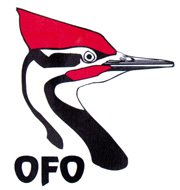By Ken Abraham
Ontario Ministry of Natural Resources. Published in OFO News 23(1):2-6. February 2005
OverviewTop
When the American Ornithologists’ Union published the 45th supplement to the Check-list of North American Birds (Banks et al. 2004), one change set in motion a flurry of activity amongst birders and goose biologists and managers. The AOU split the Canada Goose (Branta canadensis) into two species, a large-bodied group of seven subspecies that retained the name Canada Goose (B. canadensis), and a small-bodied group of four subspecies that gained the name Cackling Goose (>B. hutchinsii). Studies of mitochondrial DNA, passed to offspring only by females, indicate that these two groups separated about 1,000,000 years ago. The Canada Goose complex, also sometimes called the white-cheeked goose complex (e.g. Aldrich 1946) is among the most studied species of North American birds (Mowbray et al. 2002). Although this is partly because of its significance to waterfowl hunting and the need for sustainable management, it also is due to the great variation in morphology and colour, migration, and behaviour that the birds exhibit. Owen (1980) stated “The Canada Goose remains the supreme example among geese of the adaptation of a single species for a range of environmental conditions, over the whole of the North American continent.”
Since the AOU Check-list update, birders across the continent have been scrutinizing Canada Goose flocks to find Cackling Geese. This is especially true in eastern North America, where recognition of the small forms of Canada Goose has been a specialized pursuit by a few birders, because their occurrence is much more limited than that of larger forms. In western North America, where three Cackling Goose subspecies are regularly found, birders, hunters and waterfowl managers deal with questions of identification daily (Johnson et al. 1979). Many eastern sightings have been posted to bird listservs, e.g. Ontbirds, discussed on chat lines, e.g. ID-Frontiers, and written about on websites, e.g. Ohio Ornithological Society. In general, the content of these postings reflects new or renewed interest in the group, but it also reveals much consternation about the difficulties of identification. David Sibley has an excellent summary on his website: www.sibleyguides.com/canada_cackling.htm of “what we know” about identification of the two species. I recommend his account as a general starting point for considering the problems of field identification. In particular, I think he’s done birders a great service by bringing attention to the high variation of form within each subspecies, as opposed to simply assuming field recognizable distinctiveness. No single characteristic (breast colour, bill size, bill shape, white neck band, throat stripe, voice, etc.) definitively distinguishes among the choices. For a similar approach to the question of subspeciation, one which stresses overlapping variation, intergradation, and gradual development of modern forms and their distributions, see Ogilvie (1978). Sibley’s approach highlights the difficulty of field identification and the caution needed when considering assumptions about subspecies, i.e. that they must be heavily qualified by recognition of this overlapping variation. For recent treatments of geographic distribution, morphological and genetic variation and biology of the white-cheeked goose complex, see Dickson (2000) and Mowbray et al. (2002).
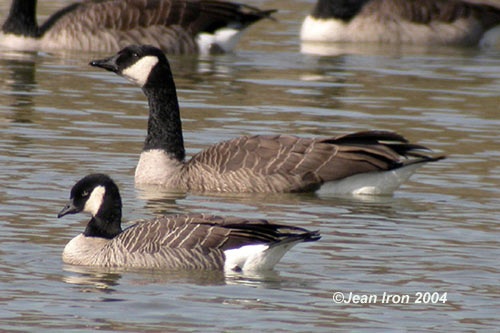
Cackling Goose (Branta hutchinsii) with Canada Goose (Branta canadensis maxima or interior) near Toronto, Ontario on 6 October 2004.
Photo: Jean Iron
What is known about Cackling Geese in Ontario?Top
Nothing has changed since the AOU Check-list update except the name! Cackling Geese did not suddenly become more abundant here, they didn’t change their migration route to accommodate our life lists, and they don’t know that they’re being watched more closely. The primary purpose of this article is to bring everyone onto “the same page” about their status in Ontario so that we can enhance our knowledge about this interesting “new species”. A secondary purpose is to provide a framework for consideration of field identification of Cackling Geese in Ontario. Information in this article on the new species Cackling Geese is based on a direct information transfer from subspecies of the former small Canada Goose (Dickson 2000 and Mowbray et al. 2002), unless otherwise specified.
Published EvidenceTop
First, what do Ontario checklists and other published sources tell us about the status of Cackling Geese? James (1991) listed four subspecies of [then] Canada Goose (interior, parvipes, moffitti=maxima, hutchinsii) for Ontario, only the last of which is now considered Cackling Goose. Although he lists it as a “rare transient, mainly on the north coast; occasional, rare winter resident in the south”, I provided a revised assessment (Abraham 1997) of hutchinsii as a “regular and abundant migrant in northern Ontario in spring and fall” based on published and unpublished Ontario Ministry of Natural Resources (OMNR) and Canadian Wildlife Service (CWS) population and harvest survey information. Pittaway (1996) added B. c. minima, now the Cackling race of Cackling Goose, to the list for Ontario, but only as an escape from captivity. Although James (1991) listed the subspecies Lesser Canada Goose (B. c. parvipes) as “probably a rare transient in the Northwest”, he reported no Ontario specimens, and Pittaway (1996) noted that parvipes may occur but has not been recorded. Placed in the large-bodied species based on the genetic analysis, this smallest form of Canada Goose is nevertheless similar in size to the largest small-bodied Cackling Goose.
DistributionTop
Next, let us consider where the Cackling Geese subspecies are found nesting, the obvious starting point to answering the question “where do Cackling Geese seen in Ontario originate?” The range descriptions in the AOU Check-list update are sparse and do not describe the subspecies ranges. Further, because genetic analysis of specimens from the nesting areas is extremely limited, current descriptions of nesting distribution are based largely on morphometric discrimination and banding studies (Dickson 2000). The nominate subspecies (B. h. hutchinsii), formerly Richardson’s Canada Goose, nests in the low to high Arctic to the north and northwest of Ontario and Manitoba, on the western Hudson Bay coast, Southampton Island, on southwestern Baffin Island, and probably in tundra areas of the eastern and central Arctic to about 110 °W longitude (Victoria Island). Nesting of all other Cackling Goose subspecies is confined to the extreme western part of North America. Taverner’s (B. h. taverneri) nests in northern Alaska and migrates and winters along the Pacific Flyway and coast. Cackling (B. h. minima) nests only in southwest Alaska, and Aleutian (B. h. leucopareia) nests only in the Aleutians Islands. Migration and wintering of the latter two subspecies are limited to narrow corridors in extreme western North America.
For completeness, we need to consider where the Lesser Canada Goose (B. c. parvipes), reportedly nests and migrates, because this small Canada Goose is likely to be confused with Cackling Geese wherever they overlap in range. B. c. parvipes nests in forest and taiga west of about 110°W to eastern interior Alaska, and migrates through the prairies west of Manitoba through the US Great Plains states as the Short Grass Prairie Population (MacInnes 1966). Despite the split, there is considerable uncertainty about the distribution, morphology and genetic status of parvipes, and the occurrence of hybridization with presumed hutchinsii and taverneri. However, neither banding nor genetic evidence exists from the vast mainland interior of the continent north of the prairies and west of the Hudson Bay coast as far west as interior Alaska to sort out which forms are present.
Banding EvidenceTop
Next, let us consider what banding records of Cackling Geese tell us about their occurrence in Ontario. The distribution of recoveries of B. h. hutchinsii banded between 1987 and 2001 by the CWS on three important nesting areas (Baffin Island, Southampton Island and western Hudson Bay coast) is shown in Figure 1.
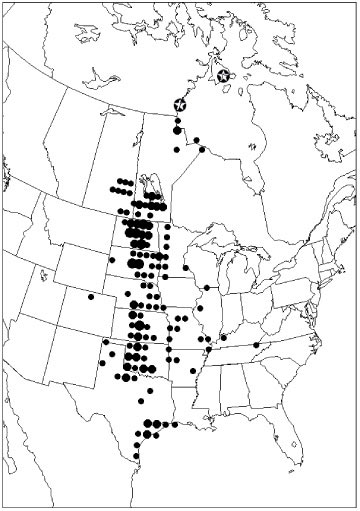
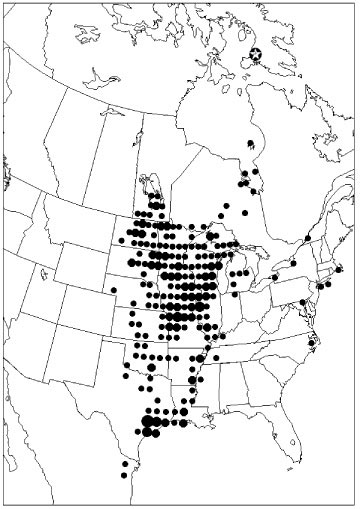
Figure 1. Stars at top of maps indicate breeding areas where Cackling Geese (Branta hutchinsii hutchinsii) were banded in Nunavut during 1987-2001 by the Canadian Wildlife Service. Black dots show recovery distribution for birds banded at west Hudson Bay and Southampton Island (first map) and on Baffin Island (second map). Courtesy of Dale Caswell, Canadian Wildlife Service.
All Ontario recoveries from this banding effort were from birds banded on Baffin Island. The pattern of recoveries suggests a distinct migration route through eastern Hudson Bay, western James Bay, and northcentral Ontario. The absence of any recoveries from the Hudson Bay Lowland west of Cape Henrietta Maria flies in the face of what we know about the commonness of small Canada Geese in spring and fall migration (see below). In fact, recoveries from earlier banding 1959-1971, (MacInnes 1966 and unpublished) show that some Hudson Bay Lowland birds come from both Southampton Island and the McConnell River area. The difference between periods may represent a change in abundance, a shift in migration routes, or different patterns of reporting from the Severn-Winisk communities, or it may indicate that CWS banding from 1987-2001 left some portion of the nesting range of B. h. hutchinsii untouched. This presents a challenge to goose banders and managers. Note that birds from Baffin Island were recovered more frequently in eastern North America than birds from the other two areas. Perhaps just as importantly, CWS banding on central and western Arctic nesting areas of B. h. hutchinsii and B. c. parvipes shows that there were no recoveries from Ontario or anywhere east of Saskatchewan in Canada or in the US, east of the Central Flyway (approximately the Missouri River) from over 9000 geese banded between 1975 and 1994 (Hines et al. 2000). Additionally, there are no recoveries in Ontario of B. h. minima, B. h. taverneri or B. h. leucopareia based on banding in their known ranges (USGS/CWS banding database, 2004).
OMNR records from banding during the flightless period (July-August) since 1971, include fewer than 10 small Canada Geese among over 200,000 Canada Geese banded in Ontario. Three of these were caught in summer 2004. This underlines the rarity of Cackling Geese in Ontario in summer and eliminates it from the list of regularly breeding species.
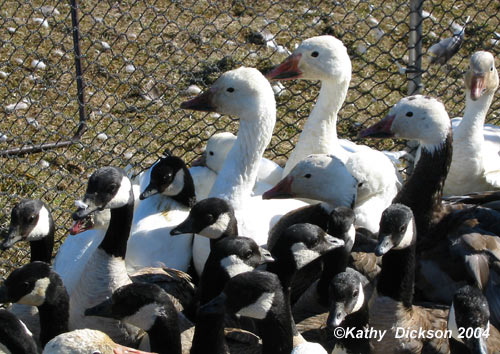
Photo: Kathy Dickson, Canadian Wildlife Service
Cackling Geese (Branta hutchinsii hutchinsii) with white and blue morph Lesser Snow Geese (Chen caerulescens caerulescens), and one Ross’s Goose (Chen rossii) on 17 August 2004, southwestern Baffin Island, Nunavut.
Specimens, Measurements and Other DataTop
From the banding studies, we can conclude that most or all wild Cackling Geese observed in Ontario are the nominate B. h. hutchinsii subspecies. What other evidence is there about Cackling Goose in Ontario and does it support this conclusion? The Royal Ontario Museum (ROM) holdings include seven birds identified as Cackling Goose, all are referred to B. h. hutchinsii. The oldest hutchinsii specimens are from “about 1875” from St. Vincent Township, Grey County, from Port Rowan (1896), and from Toronto (1905). All are autumn juvenile birds and because juvenile geese stay with their parents for a year, these specimens indicate that migrant families of Cackling Geese have occurred in Ontario for over a century, thus substantiating the species long-standing presence among Ontario’s avifauna. The other ROM specimens include another autumn juvenile from Cockburn Island, Manitoulin, in 1959, one reproductively immature bird from west of Cape Henrietta Maria in July 1957, and two birds from Eastside River, near Geraldton, in June 1978, presumably migrants. All of this information supports the conclusion based on banding results.
Morphological measurements of hunter-killed birds from the Ft. Severn to Winisk area of the Hudson Bay coast from 1956 to 1962 (H.G. Lumsden, unpublished data) were intermediate between published averages for B. h. hutchinsii and B. c. parvipes. Measurements by MacInnes (1966) show that McConnell River birds are slightly larger than Southampton Island birds on average, but individuals from both areas occur across the entire range of sizes, forming a single statistical distribution that covers the full range of published measurements for hutchinsii and parvipes. Recent genetic evidence indicates that birds in those areas are small-bodied hutchinsii genotypes. Combined with the banding results these factors strongly indicate the presence of only nominate hutchinsii in the eastern Arctic and in Ontario.
Other kinds of information are available. Aerial surveys of the whole James Bay and Hudson Bay coasts of Ontario in autumn 1979 and 1980 yielded total numbers of staging small Canada Geese of 48,500 and 38,100 (Thomas and Prevett 1982) Additionally, autumn harvest records from Cree goose camps and OMNR check stations and spring harvest records from Cree subsistence harvest surveys document the regularity and commonness of small white-cheeked geese in northern Ontario (Prevett et al. 1983). I observed hundreds during spring migration in May 1983 near Winisk during a stay with Cree hunters, and again in May 1994-1997 on the James Bay coast. From all these sources, it is clear that the species is an abundant spring and fall migrant in northern Ontario. It is interesting to note that the migration route indicated by band recoveries (Figure 1) is similar to that of Lesser Snow Geese (Chen caerulescens caerulescens) in Ontario (Gauthier et al. 1976) and the two species are often seen migrating in mixed skeins (K. Abraham, pers. obs.).
I know of no comprehensive list of records of small geese in Ontario, but many such records exist from a variety of sources, including observational records, photographs, Ontbirds postings, North American Birds, American Birds, Audubon Field Notes, OMNR banding records, and personal correspondence (K. Abraham, H.G. Lumsden, in litt.). Outside the Hudson Bay Lowland, more observational records in Ontario occur in the autumn than in spring or winter. For example, Dan Bascello (pers. comm.) reports a steady increase of Richardson’s Geese over the past 15 years in the agricultural areas west and south of Thunder Bay, with a peak of about 1500 birds during the autumn 2004 migration period. This coincides with a reported increase in the Tall Grass Prairie Population of B. h. hutchinsii (Dickson 2000). Reports on Ontbirds show that 1999 was a good year for observations in southern Ontario, equal to 2004 even with its increased awareness and more deliberate searching. B. h. minima, the smallest and darkest form of Cackling Goose, has been reported in Ontario, but these are categorized as escapes from captivity (Ron Pittaway, pers. comm.). The Ontario Bird Records Committee has reviewed one report of minima in Ontario, but the identification was not accepted (Alan Wormington, pers. comm.). This subspecies, because of its uniqueness, is widely held and bred in captivity by avicultural enthusiasts in Ontario and elsewhere (CWS, unpublished data). Angus Wilson (pers. comm.) noted regular reports of minima from one location in the Lake Champlain area of New York. The likelihood of cross-continent migration of minima is extremely low and so far, undocumented.
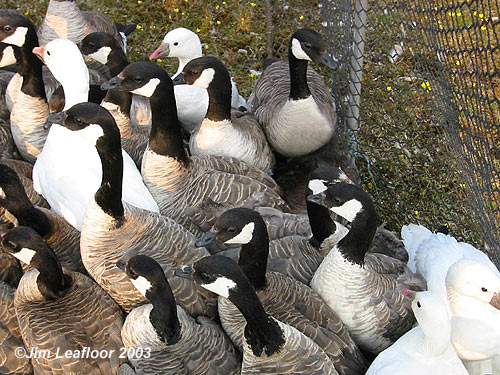
Photo: Jim Leafloor, Canadian Wildlife Service
Cackling Geese (Branta hutchinsii hutchinsii) with Ross's Geese (Chen rossii) and one probable hybrid Snow x Ross's Goose (left) in July 2003 on Southampton Island, Nunavut. Note similar size of Cackling Geese and Ross’s Geese.
IdentificationTop
How should we approach identification of Cackling Geese in Ontario? Some caveats are needed. First, as good and as useful as photographs can be, they can also easily mislead. Thus, we need reference objects or birds in the photos whenever possible. Second, there is a tremendous amount of morphological variation within the white-cheeked geese that we see in Ontario. The temperate breeding stock which has proliferated and been translocated around the province comes from mixed genetic stock (at least B. c. maxima, moffitti, interior, canadensis). In any Canada Goose flock at the height of migration, introduced birds plus wild interior birds can be present. There is also age and sex variation, e.g. young in their first fall may only be 90% of adult size. Finally, Leafloor et al. (1998) showed that some variation in size within a subspecies can be environmentally induced: B. c. interior from Akimiski Island in James Bay are smaller than mainland interior birds, consistent with a hypothesis of limited food resources. It should be noted that Akimiski geese (interior) are still large-bodied and differ only by millimetres in head length from other interior birds from Ontario and from temperate Canada Geese. They are substantially larger than either parvipes or hutchinsii. Despite being called “runts”, they are too large to be confused with Cackling Geese.
We are left with identifying Cackling Geese based on poorly quantified and often vague descriptions of size, shape and colour. We must rely whenever possible on measurements and photographs of birds from various Cackling Goose nesting areas for comparisons with birds observed in Ontario. Photographs or data from small geese taken elsewhere (e.g. migration or wintering areas) usually should not be considered representative, unless the latter birds were marked on nesting areas. Most Ontario birds will be the nominate form B. h. hutchinsii and most (particularly in southern Ontario) will be from Baffin Island, so I would give data and photographs from there greater consideration where uncertainty exists. Photographs and data from nesting areas of other Cackling Goose subspecies should also be sought.
The least likely forms in Ontario are the three Alaskan subspecies. Identification of the most distinct form minima should be relatively simple (Johnson et al. 1979). This form is distinctly dark-breasted, a warm grey-brown colour with “a purplish cast” (Johnson et al. 1979), with much less contrast between the back and the breast thanhutchinsii. B. c. minima is the smallest Cackling Goose subspecies and the one that comes close to the oft-repeated but usually unwarranted description “as small as a mallard” (female minima body mass at start of incubation is about 1400 grams compared with female mallards at less than 1300 grams) but the length of the tarsus (the long leg bone) which is a better indication of height, is 78-83 mm for adult minima females-males, nearly two times larger than Mallards (44-46 mm). If a suspected minima is observed in Ontario, it should be reported immediately on Ontbirds and we need photographs in good light showing the bird in direct comparison with other well-known bird species. Any hunter-shot birds of probable minima should be sought as donations to the ROM. The other two subspecies are equally unlikely to occur wild in Ontario. B. h. leucopareia is considerably larger than minima with a browner back and a grey-brown breast lacking the purplish tones. B. h. taverneri is somewhat larger and paler again than leucopareia. All subspecies can have white neck rings and all can have individuals with black throat stripes, so neither are definitive of western subspecies.
For comparison, the juvenal breast plumage of hutchinsii is a uniform grey, darker and less notably buff tipped than adults, and lacks the brownish-purplish tones of minima. This plumage begins to molt as soon as goslings reach flight and is likely replaced by the first basic plumage by the time they reach southern Ontario.
The problem of Branta canadensis
parvipesTop
The status of parvipes is confusing, making its addition to the Ontario checklist problematic and contentious. Based on its presumed nesting and migration range, parvipes may be occasionally found in Ontario and is most likely to be confused with hutchinsii in Ontario. While larger than hutchinsii on average, overlap in size, bill shapes, breast coloration and other characteristics between parvipes and hutchinsii make field and photo identification a real problem. Indeed, there is some evidence of genetic intergradation of parvipes with two subspecies of the Cackling Goose (taverneri and hutchinsii) based on analysis of nuclear genes contributed to offspring by both parents (Mowbray et al. 2002). This makes hybrids a possibility (though rare) in Ontario and adds to the dilemma and near impossibility of field identification. The confirmation of parvipes or any Cackling Goose subspecies other than hutchinsii in Ontario is something birders and hunters may be able contribute from well documented photographs and specimens.
We will be in a better position for field identification in Ontario and elsewhere in the east when CWS completes its analysis of morphological data from the full eastern North American nesting range of B. h. hutchinsii adding Baffin Island to the series of measurements from McConnell River and Southampton Island (MacInnes 1996; specimens in the Canadian Museum of Nature) and especially when DNA based analysis of distribution becomes available.
AcknowledgementsTop
I appreciate the help of Mark Peck of the Royal Ontario Museum who gave me access to the collection, and Jean Iron and Ron Pittaway for helpful suggestions that improved the article.
Literature CitedTop
1997. Small Canada Geese in Ontario. OFO News 15(1):4.
1946. Speciation in the white-cheeked geese. Wilson Bulletin 58: 94-103.
2004. Forty-fifth supplement to the American Ornithologists’ Union Check-list of North American Birds. Auk 121: 985-995.
2000. Towards conservation of the diversity of Canada Geese (Branta canadensis). Canadian Wildlife Service Occasional Paper No. 103.
1976. Observations on the spring migration of Snow Geese from southern Manitoba to James and Hudson Bays. Canadian Field-Naturalist 90:196-199.
2000. Population status, distribution, and survival of Shortgrass Prairie Canada Geese from the Inuvialuit Settlement Region, Western Canadian Arctic. Pages 27-58. In K. M.Dickson, 2000. Towards conservation of the diversity of Canada Geese (Branta canadensis). Canadian Wildlife Service Occasional Paper No. 103.
1991. Annotated checklist of the birds of Ontario. Royal Ontario Museum Life Sciences Miscellaneous Publication, Second Edition, Revised and Expanded. R.O.M., Toronto.
1979. Morphological characteristics of Canada geese in the Pacific Flyway. Pages 56-80. In R.L. Jarvis and J.C. Bartonek (eds.), Management and Biology of Pacific Flyway Geese, Oregon State University Bookstores, Inc., Corvallis.
1998. Environmental effects on body size of Canada geese. Auk 115: 26-33.
1966. Population behaviour of eastern Arctic Canada Geese. Journal of Wildlife Management 30(3): 536-553.
2002. Canada Goose (Branta canadensis). In Birds of North America, No. 682 (A. Poole and F. Gill, eds.). The Birds of North America, Inc., Philadelphia, PA.
1978. Wild Geese. Buteo Books, Vermillion, South Dakota.
1980. Wild Geese of the World. Batsford Books, London.
1996. Checklist of Recognizable Forms in Ontario OFO News 14(3):4-5 (updated October 2004)
1983. Waterfowl kill by Cree hunters of the Hudson Bay Lowland, Ontario. Arctic 36 (2):185-192.
1982. The roles of the James and Hudson Bay Lowland in the annual cycle of geese. Naturaliste Canadien 109:913-925.
